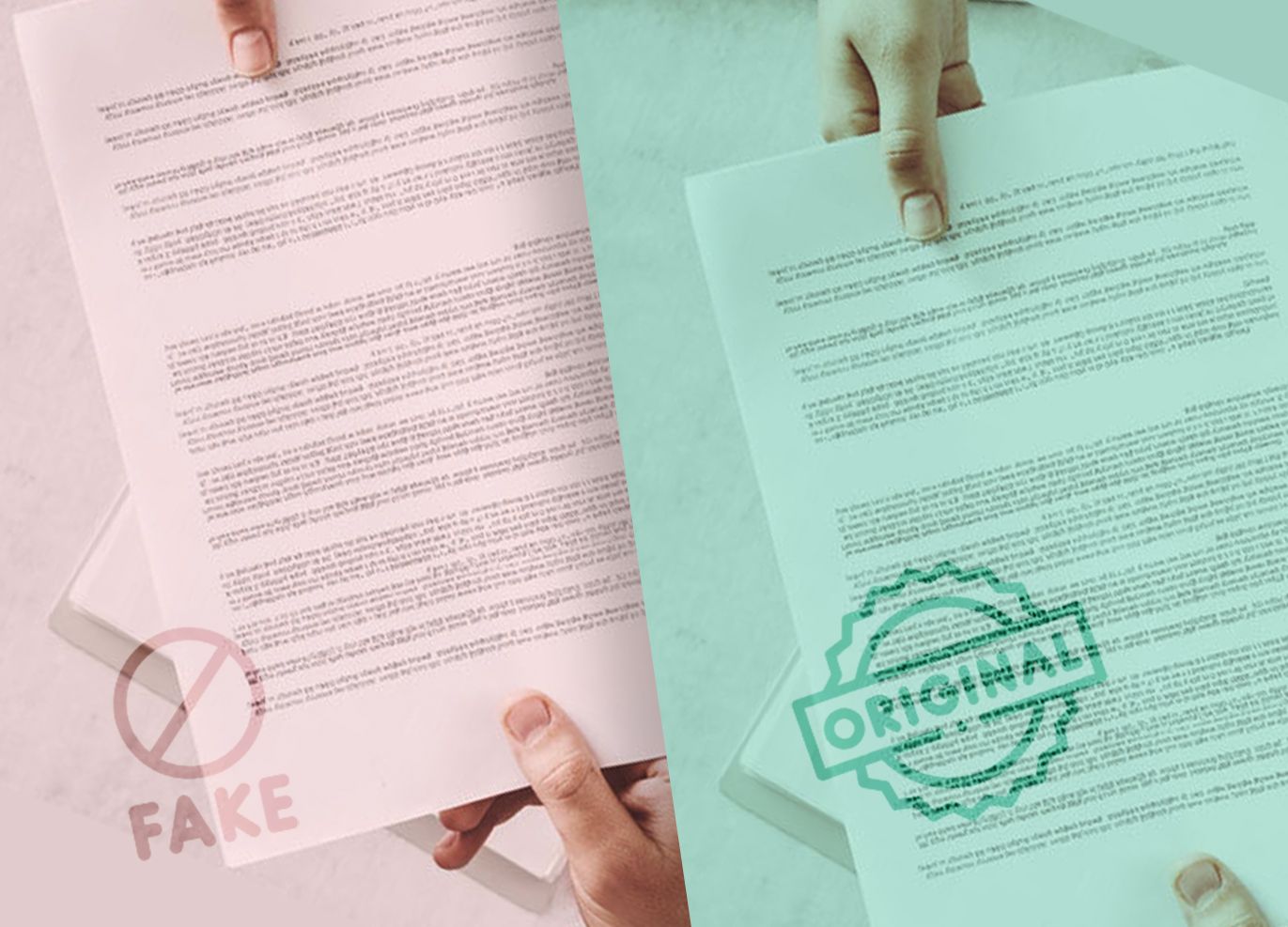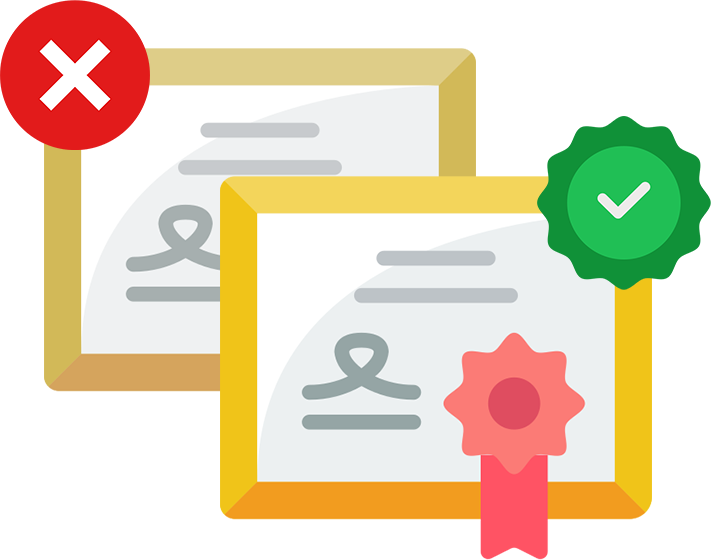What is document verification?
Document verification is a critical process that government agencies, businesses and organisations employ to authenticate or confirm the legitimacy of a document presented by an individual during the customer onboarding process. It systematically examines submitted documents to ensure their authenticity, accuracy, and consistency. This process often involves document authenticity verification and document checking procedures.
The process of customer onboarding may seem simple; however, if the document verification process is not done accurately, it can lead to bigger issues, such as the risk of onboarding a fraudster. With the recent rise in internet fraud and technology, fraudulent individuals can take advantage of AI and other technologies to produce fake documents to imitate the original copy, such as school certificates and other professional certificates.
However, following this guideline on how to verify documents, which will be explained in this article, will help businesses and government agencies mitigate fraud drastically, if not eliminate it, while complying with regulatory requirements.
This blog post will delve into the intricacies of document verification, answering your questions on how to verify documents online, how do i verify documents, how to officially verify a document, how do you verify the authenticity of a document, exploring how it's done, introduce tools like automated online document verification, its importance, and real-world examples.

What is Document Verification? Document Verification Meaning
Document verification, also known as document validation, is a comprehensive procedure used to confirm the authenticity and legitimacy of presented documents. It is an important step in customer onboarding and serves as a cornerstone for establishing trust and mitigating risks associated with fraudulent activities. By doing document verifications, businesses, government agencies, and other institutions can perform their due KYC verification process.
Before seeing how to verify documents, let us look at more reasons the document verification process is important.
Why is the Document Verification Process Important?
Why is it important for businesses to validate the authenticity of documents? Here are 7 reasons why you should verify the documents of an intending employee during your customer onboarding process:
1. Fraud Prevention:
Arguably, fraud prevention is the first important reason why you need to verify the documents of an intending employee as a business. Generative AI has been implicated in aiding fraud. Also, fake ID markets are just a Google search away coupled with the fact that document fraud rose by a whopping 79% in 2022, when AI usage was not in use as it is now. By ensuring that documents are authentic, verification documents and document checking, organizations can prevent fraudulent activities that could lead to financial losses.
2. Regulatory Compliance:
Many industries are required to adhere to strict regulations regarding document and identity verification such as AML and KYC regulations. Proper document verifications helps organizations comply with these laws.
3. Trust Building:
Establishing a robust document verification process enhances customer trust and confidence in the organization.
4. Operational Efficiency:
Reduce time spent on manual document verification checks.
5. Risk Management:
Identify and eliminate high-risk individuals.
6. Accuracy:
Minimize human errors.
7. Global Scalability:
Use online document verification software to verify users across borders.
What are the Different Types of Document Verification Methods?
There are several ways documents can be verified. Let us look at the most important and common ways of verifying documents:
1. Manual Document Verification:
This involves a human expert physically checking the documents such as passports or IDs for physical signs of tampering like holograms, microtext or watermarks and the overall consistency that distinguishes fake from original documents.
Physical verification of documents also includes manually checking the information on the document and confirming the details against external databases or records.
2. Digital Verification of Document
Digital or online document verifications includes several methods such as:
I. Optical Character Recognition (OCR):
This type of verification of documents involves the extraction of text from scanned documents for further analysis and verification.
II. Image Analysis:
This involves using algorithms to analyse document images for security features, inconsistencies or signs of forgery. Digitized verification companies are often experts in this process.
III. Biometric Verification:
This document verification process involves comparing biometric data (fingerprints, facial recognition) to the document photo for identity verification.
IV. NFC Verification:
HFC verification of documents method uses Near-Field Communication technology to read embedded data in documents for authentication.
V. Machine Learning-Based Verification
Employing AI for document verification checks to identify patterns and anomalies in documents, improving accuracy over time.
Many companies now use automated document verification solutions that combine these methods for faster and more accurate results.
Read: What are Machine Readable Zones in Documents?
Understanding the Process of Document Verification: How is Document Verification Done?
How do I verify documents? The document verification process typically encompasses the following steps:
1. Document Collection:
The initial stage involves gathering the necessary documents from the individual or entity. Common documents include government-issued identification cards, passports, utility bills, bank statements, and proof of address.
2. Data Extraction:
The relevant information, such as names, dates of birth, addresses, and identification numbers, is extracted from the submitted documents.
3. Document Analysis:
Next, the documents are examined meticulously to verify their authenticity and consistency. This may involve checking for signs of tampering, forgery, or discrepancies.
4. Data Validation:
The extracted data is compared against reliable databases or internal records to confirm its accuracy. This step helps identify potential inconsistencies or fraudulent information.
5. Risk Assessment:
Based on the verification results, a risk assessment is performed to determine the level of risk associated with the individual or entity. This evaluation helps in deciding the next course of action.
Using identity document verification systems can automate these steps and reduce verification time drastically. Advanced document verification systems automate this process, providing real-time document authenticity verification.

An Example of Document-Based Verification
Opening a bank account often requires identity and address proof. With document verification software, banks can validate these documents instantly and securely. This ensures compliance and mitigates identity fraud through real-time verification documents.
What are the Challenges with Manual Document Verification?
Manual documents verification checks comes with lots of challenges:
- Human error and bias
- Efficiency and scalability
- Security risks and delayed processing
- Delayed customer experience.
- Risk of tampered or altered documents
Human judgment is subjective leading to inconsistent decisions. Extended periods of manual verification can lead to fatigue ultimately increasing the likelihood of errors. Also, skilled forgers can create highly convincing documents that may bypass human detection.
Moreover, manually verifying documents can be time-consuming especially when you have to deal with large volumes of documents. It requires a dedicated workforce to handle the workload which is often scarce.
In addition to this are the security risks. Manually handling sensitive documents can increase the risk of data breaches and loss. Physical documents can also be easily tampered with, altered or replaced.
All of these mentioned challenges can lead to delays in document verification and frustrate customers.
What Happens When You Don't Verify Your Employee’s Documents and Credentials?
Failing to conduct documentation verification can lead to a host of problems for your organization. Here are some potential consequences:
I. Legal and Compliance Issues:
Operating without conducting appropriate customer due diligence can expose your company to legal and regulatory penalties. Hiring workers with fake credentials can result in your company being implicated in criminal activities.
II. Financial Losses:
An employee with falsified documents may engage in fraudulent activities, leading to financial losses. Addressing the consequences of hiring unqualified or dishonest employees can be expensive. Moreover, negative publicity associated with employment verification failures can harm your company's image.
III. Operational Risks
Employees without the necessary qualifications or experience may struggle to perform their roles effectively. Hiring individuals with criminal backgrounds can increase the risk of workplace violence or data breaches.
Benefits of Using Document Verification Software
Implementing documents verification software provides:
1. Faster onboarding
2. Scalability for global clients
3. Integration with KYC/AML systems
4. Improved fraud detection accuracy
If you're wondering how to verify documents online, these online document verification tools are the most secure and efficient options available today.
How Youverify Can Help in Automating Your Document Verification Process with 99% Accuracy?
To address these challenges that come with manually verifying documents, Youverify specializes in ID documents verification KYC (Know your Customer) service that provides a fast and secure way for businesses to verify the identity and documents of their customers. With our AI-powered document verification system, you can now quickly and easily verify your customers’ government-issued ID documents by scanning and authenticating across a global document verification network.
Don’t let fraudulent documents bypass you! This could be as dangerous as employing a terrorist or a fraud. Looking for a reliable solution for documents verification? Book a FREE demo to see how Youverify simplifies your workflow. Request a FREE demo from one of our experts today to see how our document verification checks can help.
Conclusion
The document verification process is an important aspect of modern business and governance. From document authenticity verification to online document verification, businesses must adopt scalable and secure tools to validate credentials in real time. By adopting identity documents verification tools and understanding how to verify documents online, organizations can streamline their onboarding process while keeping security tight.